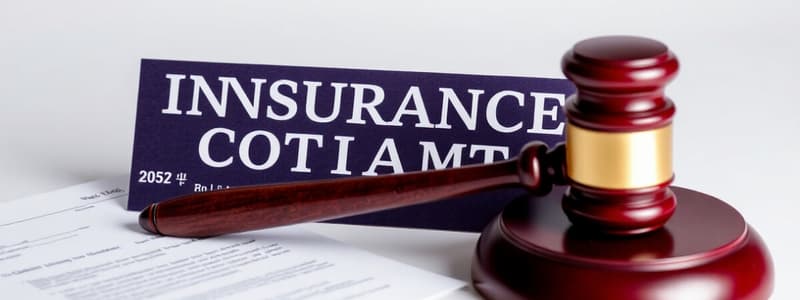Podcast
Questions and Answers
What is the primary difference between binding authority and a conditional binder?
What is the primary difference between binding authority and a conditional binder?
- Conditional binders are permanent coverage options.
- Binding authority allows agents to approve coverage instantly. (correct)
- Binding authority requires underwriting approval.
- Conditional binders provide instant coverage.
Which of the following is NOT a requirement for a legally enforceable contract?
Which of the following is NOT a requirement for a legally enforceable contract?
- Mutual funds (correct)
- Legal purpose and form
- Offer and acceptance
- Consideration
Which principle underlines the indemnity doctrine in insurance?
Which principle underlines the indemnity doctrine in insurance?
- Encourages exaggeration of losses for claims.
- Requires full replacement of property regardless of loss.
- Restores insured parties to their pre-loss financial condition. (correct)
- Allows insured parties to profit from losses.
What does an open perils policy cover?
What does an open perils policy cover?
What is the formula to calculate Actual Cash Value (ACV)?
What is the formula to calculate Actual Cash Value (ACV)?
Which of the following correctly describes an insurance contract's declaration?
Which of the following correctly describes an insurance contract's declaration?
What typically characterizes personal insurance coverage?
What typically characterizes personal insurance coverage?
What type of receipt provides temporary coverage pending underwriting approval?
What type of receipt provides temporary coverage pending underwriting approval?
What does a coinsurance clause require in a homeowner's policy?
What does a coinsurance clause require in a homeowner's policy?
Which of the following accurately describes legal liability?
Which of the following accurately describes legal liability?
What are the three types of compensable damages?
What are the three types of compensable damages?
In litigation, who bears the burden of proof?
In litigation, who bears the burden of proof?
What differentiates statutory law from common law?
What differentiates statutory law from common law?
What is an attractive nuisance?
What is an attractive nuisance?
Which of the following reflects a source of liability for automobile ownership?
Which of the following reflects a source of liability for automobile ownership?
How is insurer solvency monitored?
How is insurer solvency monitored?
What characterizes a hard market in insurance?
What characterizes a hard market in insurance?
What does the combined ratio measure?
What does the combined ratio measure?
What is the main reason for an insurance company to engage in cash flow underwriting?
What is the main reason for an insurance company to engage in cash flow underwriting?
Why is insurance primarily regulated at the state level rather than federally?
Why is insurance primarily regulated at the state level rather than federally?
What is one of the primary purposes of the NAIC?
What is one of the primary purposes of the NAIC?
How are unpaid claims handled for an insolvent insurance company?
How are unpaid claims handled for an insolvent insurance company?
What differentiates Generally Accepted Accounting Principles (GAAP) from Statutory Accounting Principles (SAP)?
What differentiates Generally Accepted Accounting Principles (GAAP) from Statutory Accounting Principles (SAP)?
What defines twisting in insurance practices?
What defines twisting in insurance practices?
Flashcards
What is agency in insurance?
What is agency in insurance?
Agency is the relationship between an agent representing an insurance company and a policyholder.
What is waiver in insurance?
What is waiver in insurance?
Waiver occurs when an insurer knowingly gives up a right under the insurance policy. For example, if an insurer allows a policyholder to continue coverage despite a late premium payment, the insurer may be waiving their right to cancel the policy for late payment.
What is estoppel in insurance?
What is estoppel in insurance?
Estoppel is a legal principle that prevents someone from denying a fact that they previously represented as true, even if the statement was incorrect. In insurance, estoppel can occur if an insurer makes a statement to a policyholder that creates a reasonable expectation of coverage, even if the statement is not technically correct.
What is the difference between binding authority and conditional binder?
What is the difference between binding authority and conditional binder?
Signup and view all the flashcards
What are the requirements of a legally enforceable contract?
What are the requirements of a legally enforceable contract?
Signup and view all the flashcards
What are the distinguishing characteristics of insurance contracts?
What are the distinguishing characteristics of insurance contracts?
Signup and view all the flashcards
Why are utmost good faith and the principle of indemnity important?
Why are utmost good faith and the principle of indemnity important?
Signup and view all the flashcards
What are the differences between a conditional and binding receipt?
What are the differences between a conditional and binding receipt?
Signup and view all the flashcards
Hard Market
Hard Market
Signup and view all the flashcards
Soft Market
Soft Market
Signup and view all the flashcards
Combined Ratio
Combined Ratio
Signup and view all the flashcards
Cash Flow Underwriting
Cash Flow Underwriting
Signup and view all the flashcards
State Regulation of Insurance
State Regulation of Insurance
Signup and view all the flashcards
National Association of Insurance Commissioners (NAIC)
National Association of Insurance Commissioners (NAIC)
Signup and view all the flashcards
State Insurance Guarantee Fund
State Insurance Guarantee Fund
Signup and view all the flashcards
Generally Accepted Accounting Principles (GAAP)
Generally Accepted Accounting Principles (GAAP)
Signup and view all the flashcards
Coinsurance clause
Coinsurance clause
Signup and view all the flashcards
Insurer solvency
Insurer solvency
Signup and view all the flashcards
Hard insurance market
Hard insurance market
Signup and view all the flashcards
Soft insurance market
Soft insurance market
Signup and view all the flashcards
Legal liability
Legal liability
Signup and view all the flashcards
Strict liability
Strict liability
Signup and view all the flashcards
Vicarious liability
Vicarious liability
Signup and view all the flashcards
Attractive nuisance
Attractive nuisance
Signup and view all the flashcards
Study Notes
Review of Insurance Concepts
-
Agency and Waiver/Estoppel: Agency is the relationship between an insurance agent and the policyholder. Waiver occurs when the agent or company accepts a risk, potentially obligating them to pay, even if a policy isn't formally binding. Estoppel prevents a party from taking a contrary position.
-
Binding vs. Conditional Binding: Binding authority grants immediate coverage, while conditional binding offers temporary coverage subject to underwriting approval.
-
Legally Enforceable Contracts: Key elements are offer, acceptance, consideration (e.g., payment), and competent parties. Legally valid contracts also require clear legal purpose and form.
-
Insurance Contract Characteristics: Good faith (honest information), indemnity (restoring the insured to their pre-loss position), fundamental principles, and important reasons. Note, personal property insurance and loss of property is covered.
-
Doctrine of Indemnity: This principle aims to restore the insured to their pre-loss financial position, not to profit from the loss. Provisions that violate this tenet exist.
-
Insurance Policy Parts (Declarations/Insuring Agreement/Exclusions/ Conditions/Endorsements/Riders): Policy Declarations state facts, Insuring Agreements outline coverage, Exclusions contain exclusions, Conditions detail requirements, Endorsements modify, Riders add additional coverage.
-
Open vs. Named Perils: Open perils cover losses resulting from any event, except excluded perils. Named perils policies cover only losses from explicitly listed events.
-
Personal Insurance Contract Modification: Specific steps must be followed to appropriately modify a personal insurance contract.
-
Property Valuation: Property is valued at the time of a loss, valued at ACV (Actual Cash Value).
-
Deductibles: Deductibles are the amounts policyholders themselves must pay before the insurance company covers the claim. The 'straight deductible' requires a fixed amount.
-
Coinsurance Clause: Requires policyholders to carry a minimum amount of insurance to avoid shared loss when a loss occurs if the amount is less than the required minimum.
-
Hard/Soft Markets: Hard markets have limited supply of insurance products and higher prices. Conversely, soft markets have abundance of supply and lower prices.
Insurance Policy and Property Valuation
-
Combined Ratio: Calculated by dividing combined losses and expenses by premiums to assess insurers' operational and market profitability.
-
Underwriting Motives: Insurers may choose to reduce profits to increase insurance sales.
-
State vs. Interstate Regulation: Insurance is largely regulated at the state level in the United States, but interstate transactions are also addressed.
Insolvency and Legal Liability
-
Insolvent Insurance Company Management: State governments usually assume oversight of an insolvent insurance company.
-
Accounting Compliance: Insurers must comply with Generally Accepted Accounting Principles (GAAP).
-
Prior Approval vs. File/Use Regulation: Prior approval requires prior authorization before an insurance company begins filing or using a claim. In contrast, file/use regulations allow claims to be filed and used before formal approval.
-
Twisting and Rebating Practices: These practices involve misleading the consumer to influence a purchase or change to an insurance plan, and are considered unethical and illegal.
Studying That Suits You
Use AI to generate personalized quizzes and flashcards to suit your learning preferences.




